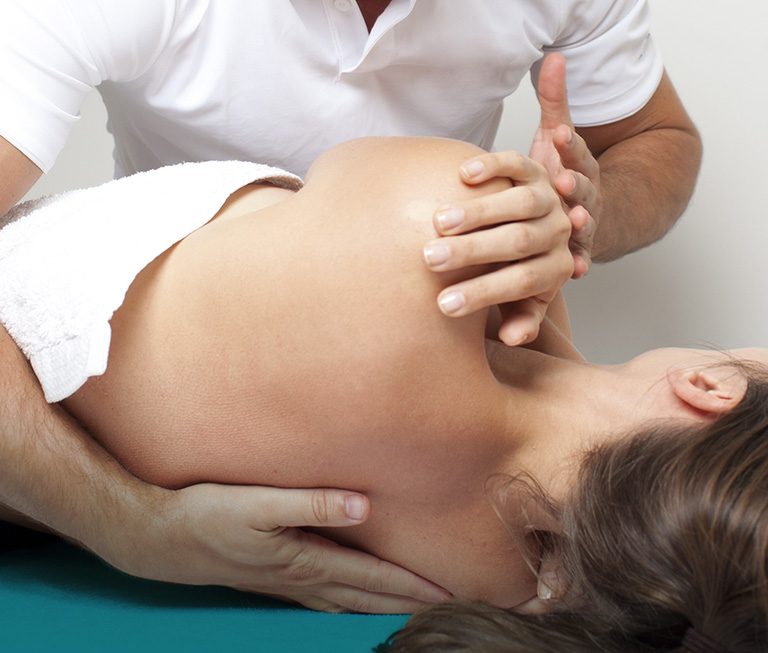Osteopathy

FAQ
1. What is osteopathy?
Osteopathy is a manual therapy based on a sound and thorough knowledge of anatomy, physiology and the biomechanics of the human body. Using these skills, osteopaths establish the links between these different systems so as to re-establish the body’s harmony during the treatment.
There are different osteopathic approaches used depending on the specific needs of each patient but none of them could be exercised isolated from the others because the human body is one whole entity.
The osteoarticular approach focuses on the reestablishment of the mechanical articular mobility restrictions of the spine, the pelvis and the limbs.
The visceral approach is based on the knowledge of anatomy, physiology and the biomechanics of the different body organs so as to reestablish correct functioning of any dysfunctional organ systems (cardio-respiratory, digestive, gynaecological etc.).
The cranial approach concentrates on the centres of intellectual and neuro-vegetative regulations by using equilibration techniques of the cranial rhythm, the diaphragms and the cranial membranes. These are gentle, low-amplitude techniques.
Finally, the fascial approach concerns the body’s fascias: tissue sheaths covering and partitioning almost the entire human body, that the osteopath treats so as to re-establish a balance between the mechanical tensions of these tissues and the dynamization of the liquid-conducting, neurological, hormonal, electrolytical and energy elements related to them.
2. Who can benefit from osteopathy?
Osteopathy is beneficial for persons of all ages – from birth right down to accompanying the end of life, whether this be for curative, preventive or even palliative purposes.
3. What problems can osteopathy relieve or cure?
Generally speaking, osteopathy can address various problems:
• Back pains
• Migraines and headaches
• Joint paints
• Digestive problems
• Breathing problems
• Gynaecological problems
• Urinary problems
• Fatigue
• Stress management
• Sleep disturbances
• Post-traumatic and post-surgery pains
• Ear infections
• Regurgitation
• Sports injuries
…and much, much more!
For the expectant mother: concerning all pains and discomforts – whether linked to pregnancy or not (back pain, migraines, digestive problems, joint pains, etc.)
To prepare the body for a gentler birth and to help stimulate labour should the birth be delayed…
For women who have recently given birth: to re-establish the body’s balance after delivery and after the difference in posture adopted during pregnancy or even to help solve health problems or pains occurring after delivery (such as breastfeeding difficulties).
For newborns: helping the newborn to solve problems occurring after a difficult, prolonged or too speedy birth; to treat a plagiocephaly (flat skull); to solve sucking problems, regurgitation or gastric reflux, colic, breathing problems, sleep problems, ear infections etc.
For children: helping them to improve their quality of life if they are suffering from asthma, ear infections or any other chronic problems. To accompany them in their growth and to address any pains linked to it.
4. Do I need to have a doctor’s referral to consult an osteopath?
You can make an appointment without having seen a doctor. Your osteopath is trained as primary worker.
However, your insurance company sometimes requires a prior doctor’s referral to reimburse the costs. Do not hesitate to contact your insurance company for further information.
5. How long does a session last and how many do I have to have?
An osteopath may vary the length of a session depending on the problem to be treated and the person’s condition. In general, a consultation lasts between 45 and 60 minutes. It is difficult to predict how many sessions will be needed to obtain results. These depend on the problem, the conditions associated to it and the evolution of your state of health. The osteopath therefore judges each case individually. In general, it is possible to estimate the number of sessions required after having assessed the development of the pain after the treatment, at the second consultation.
Most of the acute problems (less than 3 months old) can be improved within 1 to 3 sessions.
Most of the chronic problems (older than 3 months) can be improved within 5 to 8 sessions.
6. What happens at an osteopathy session?
1st step – the questionnaire: During the first meeting, the osteopath will create a file with a detailed questionnaire on your state of health and on the problem that made you consult him/her. These questions may seem far removed from the reason for your consultation, but they are essential to help the osteopath define the cause or causes of your problem.
2nd step – the assessment: During your meeting, the osteopath will ask you to be in your underwear so as to make the assessment of your posture, the observation of the tension areas, the gravity lines and the session itself easier. It is also recommended to remove any jewellery (glasses, watches, etc.) so as not to hinder the tests or to avoid that you hurt yourself with them.
3rd step – the treatment: all the information as well as that gathered in the questionnaire guide the osteopath in his/her palpatory and then therapeutic assessment for which he/she uses mobilization and manipulation techniques according to the dysfunction to treat.
Moreover, since osteopathy has a very global approach, it is not surprising that the therapist may work on zones that are far removed from the one that is making you suffer.
7. What is the difference between osteopathy, chiropractic treatment and physiotherapy?
Osteopathy has a global approach based on the search of the cause for the problems. It is not trying to treat symptoms but aims to analyze them and find the source of the dysfunction. Furthermore, osteopathy offers a wide variety of techniques not only for the musculoskeletal system (bones, muscles, joints) but also for the organs, the viscera, the blood circulation, the nervous system, the cranium, etc. (see the section on the definition of osteopathy).
8. Does it hurt?
No, it does not. Of course, if you are consulting while being in chronic or acute pain, a well adapted treatment should not increase your pains. However, it is important to remember the fact that the clinical examination or the gentle mobilization used in the performance of mechanical and neurological tests may be painful. It is important to remember that their main objective is precisely to reveal the type, the location and the characteristics of these pains. These preliminary steps that may temporarily cause some pain, are however necessary and crucial to ensure that your case does not require any immediate medical attention (a reference to your treating physician, for example). In addition, they allow detecting and identifying as exactly as possible the probable cause or causes of our pain and to enable to establish a treatment plan that will be adjusted to your state of health and your needs.
9. Who pays?
Osteopathy is a private health care service and not reimbursed by the RAMQ. You will therefore have to cover the cost for your sessions. Nonetheless, most private insurance companies reimburse a part or the entire osteopathy consultation. All osteopathy receipts are admissible for your provincial (Québec) tax declarations, if you do not have any private insurance coverage. If your private insurance company does not cover 100% of the osteopathy costs, the difference can be declared in your income tax declaration, but it is the responsibility of your insurance company to issue a statement of the costs not covered, since the osteopath cannot issue a second receipt. It will be up to you to contact your insurance company about your insurance claims.
